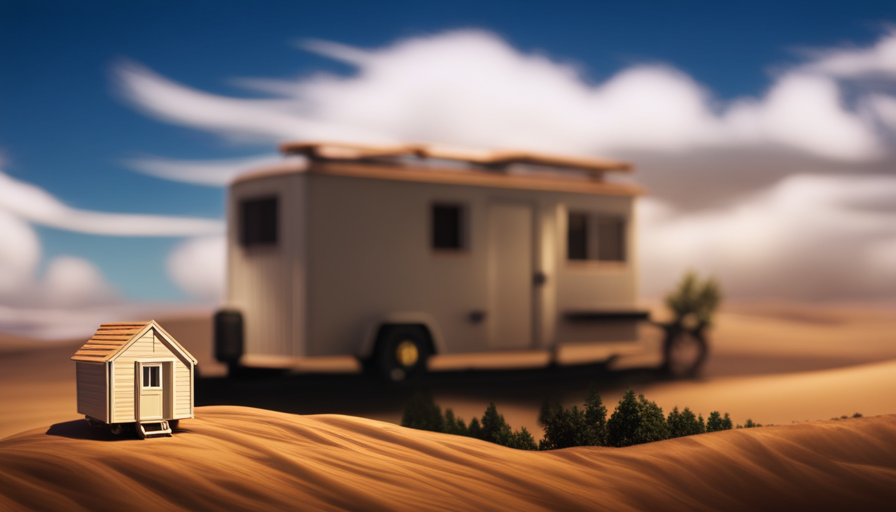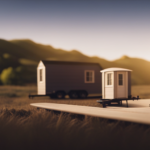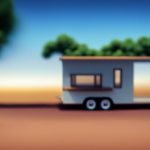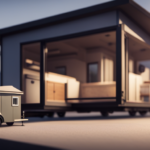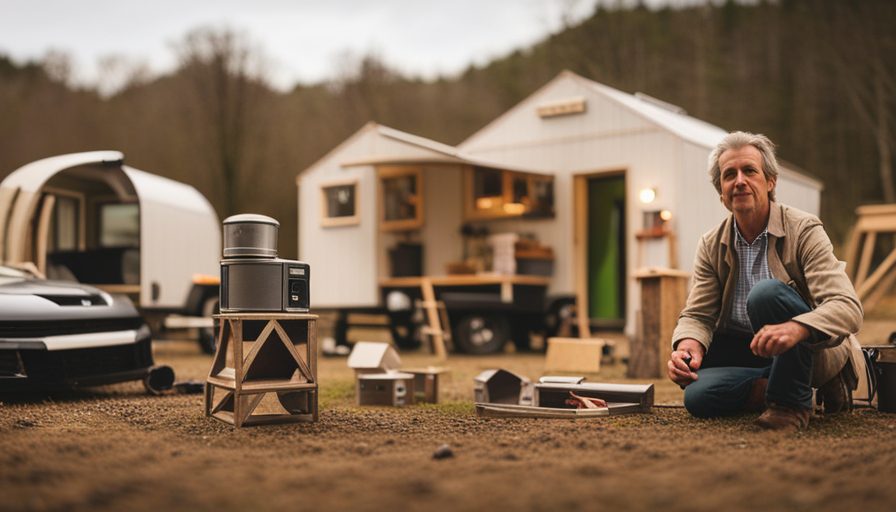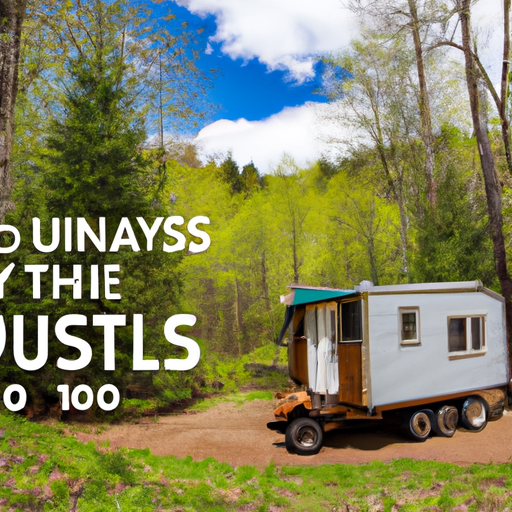You may be asking yourself, “What is the maximum length allowed for my tiny house trailer?” This is a common question that many prospective tiny house owners have. The goal is to find a balance between having enough living space while also following legal regulations and guidelines.
Well, fear not! In this article, I will guide you through the ins and outs of choosing the perfect length for your tiny house trailer.
From understanding the basics of tiny house trailers to exploring legal restrictions and regulations, we’ll cover it all. I’ll discuss the factors you need to consider when choosing a trailer length, common trailer lengths for tiny houses, and the pros and cons of longer trailers.
We’ll also delve into customizing your trailer length and maximizing space in your tiny house on wheels.
And of course, safety is a top priority. So, we’ll touch on important safety considerations when towing a longer trailer.
By the end of this article, you’ll have all the information you need to find the perfect trailer length for your tiny house journey.
Let’s get started!
Key Takeaways
- Choosing the right length for a tiny house trailer is crucial for both comfort and compliance with legal restrictions.
- Factors such as living space size, number of occupants, and desired mobility should be considered when determining the trailer length.
- Legal restrictions on trailer length vary by state, typically ranging from around 28 to 30 feet maximum.
- Shorter trailers offer more flexibility and maneuverability, while longer trailers provide more living space but may have limitations in towing capacity and parking.
Understanding the Basics of Tiny House Trailers
You’ll need to understand the basics of tiny house trailers in order to determine how long your trailer can be. Maximizing storage and ensuring proper trailer weight distribution are key factors to consider.
When it comes to storage, every inch counts in a tiny house. Therefore, it’s important to make the most out of the available space. This can be achieved through clever design and utilizing built-in storage solutions, such as under-bed compartments, wall-mounted shelves, and multi-functional furniture pieces.
Additionally, it’s crucial to distribute the weight of the trailer evenly to ensure safe towing. Placing heavy items near the axles and keeping the overall weight centered will help maintain stability on the road.
Now, let’s move on to the next section, where we’ll discuss the legal restrictions and regulations on trailer length. It’s important to understand these guidelines to ensure compliance and avoid any potential issues when it comes to the length of your tiny house trailer.
Legal Restrictions and Regulations on Trailer Length
There’s a limit on the length of a trailer for a tiny home, so it’s important to adhere to the legal restrictions and regulations to ensure compliance. Understanding the legal restrictions and regulations on trailer length is crucial when designing and building a tiny house.
The exact limitations vary depending on the state and local regulations, but generally, the maximum length for a tiny house trailer is around 28 to 30 feet. Some areas may allow longer trailers, but it’s essential to check the specific rules in your location.
Exploring the benefits of shorter trailers in tiny house living, they offer more flexibility and maneuverability. They are easier to tow and navigate through narrow roads or tight spaces. Additionally, shorter trailers are often more cost-effective, as they require less materials and are lighter, reducing the strain on the towing vehicle.
When choosing a trailer length for your tiny house, there are several factors to consider. These include the size of your living space, the number of occupants, and your desired level of mobility. It’s important to find a balance between having enough space and keeping the trailer within legal limits.
By understanding the legal restrictions and regulations on trailer length and considering these factors, you can ensure that your tiny house is both compliant and suitable for your needs.
Factors to Consider When Choosing a Trailer Length
Consider the factors that come into play when deciding on the size of your mobile living space. The length of your tiny house trailer is a crucial aspect to consider, as it affects not only the customization options but also the overall mobility of your home.
Customizing options are greatly influenced by the length of the trailer, as a longer trailer allows for more space and flexibility in designing the layout of your tiny house. You can include additional features such as a separate bedroom, a larger kitchen, or even a small workspace. On the other hand, a shorter trailer may limit your customization options and require more creative ways to maximize space.
Another important factor to consider is the impact on mobility. Longer trailers may be more challenging to maneuver and navigate through narrow roads or tight corners. They may also require a larger towing vehicle and may have restrictions on where you can park or camp.
Shorter trailers, on the other hand, offer greater ease of mobility and flexibility in terms of parking and maneuverability.
As we delve into the subsequent section about common trailer lengths for tiny houses, it is important to understand these factors and how they can influence your decision-making process.
Common Trailer Lengths for Tiny Houses
When it comes to selecting the perfect size for your mobile living space, it’s crucial to be aware of the common trailer lengths used in the world of tiny houses. Common trailer sizes for tiny houses range from 16 feet to 28 feet in length. Each length has its own benefits and considerations.
A 16-foot trailer is a popular choice for those looking for a compact and easily maneuverable tiny house. It offers simplicity and affordability, making it ideal for those on a budget or who prefer a minimalist lifestyle. However, it may be too small for those who desire more space or have larger furniture.
Moving up to a 20-foot trailer provides a bit more room to work with. It allows for additional living space and flexibility in design. This length is a good compromise for those who want a bit more comfort without sacrificing mobility.
For those who desire even more space, a 24-foot or 28-foot trailer may be the way to go. These longer trailers offer ample room for a comfortable living area, kitchen, bathroom, and even a separate bedroom. However, they may be more challenging to tow and maneuver in tight spaces.
The common trailer lengths for tiny houses range from 16 feet to 28 feet, each with its own benefits and considerations. Now let’s explore the pros and cons of longer trailers in the next section without writing ‘step’.
Pros and Cons of Longer Trailers
While longer trailers offer more living space for a comfortable lifestyle, they can be like navigating a large ship through a narrow canal, requiring careful maneuvering and attention to detail. When considering the length of your tiny house trailer, it’s important to weigh the pros and cons before making a decision. Here are some key points to consider:
-
Maximizing Storage: Longer trailers provide more room for storage options. With additional square footage, you can incorporate built-in cabinets, closets, and shelves to keep your belongings organized and easily accessible. This is especially beneficial if you have a large collection of items or plan to live in your tiny house for an extended period.
-
Towing Capacity: Longer trailers can potentially limit your towing capacity. It’s crucial to ensure that your vehicle can safely tow the increased weight and length. You may need to upgrade your towing system or opt for a larger, more powerful vehicle. Failing to do so can lead to safety hazards on the road.
-
Increased Stability: Longer trailers tend to offer better stability while traveling. The extended length distributes the weight more evenly, reducing the risk of swaying or fishtailing. This can provide a smoother and more comfortable towing experience.
-
Parking and Maneuverability: Longer trailers can be challenging to park and maneuver in tight spaces. It’s important to carefully plan your parking arrangements and consider the accessibility of your desired locations. Additionally, turning corners and navigating narrow roads may require more attention and precision.
Transitioning to the subsequent section about the pros and cons of shorter trailers, it’s important to consider the trade-offs of both options.
Pros and Cons of Shorter Trailers
In my previous section, I discussed the pros and cons of longer trailers for tiny houses. Now, let’s explore the other side of the spectrum and delve into the advantages and disadvantages of shorter trailers.
When it comes to tiny house trailers, shorter lengths have their own set of benefits and drawbacks. One of the main advantages is the ease of maneuverability. With a shorter trailer, it becomes much simpler to navigate tight corners, narrow roads, and parking spaces. This can be particularly advantageous for those who plan to frequently move their tiny house.
However, shorter trailers also come with a trade-off. The biggest challenge is maximizing space within a limited area. Every square inch counts in a tiny house, and a shorter trailer means less room for all the essentials. Careful planning and creative storage solutions are crucial to ensure that all your belongings fit comfortably.
Additionally, towing safety is a critical consideration with shorter trailers. The weight distribution and balance become even more crucial when dealing with a smaller space. Proper weight distribution, a sturdy hitch, and appropriate towing equipment are essential to maintain stability and prevent accidents.
As you can see, there are both advantages and disadvantages to opting for a shorter trailer for your tiny house. Now that we have explored the pros and cons of different trailer lengths, let’s dive into the next section and discuss customizing your trailer length to fit your specific needs.
Customizing Your Trailer Length
To truly make your tiny home unique and perfectly suited to your lifestyle, why not customize the length of your trailer? By choosing the right trailer length, you can maximize storage space and optimize the layout of your tiny house on wheels.
Customizing your trailer length allows you to have complete control over the dimensions of your tiny house. Here are some benefits of customizing your trailer length:
-
More storage: With a longer trailer, you can incorporate additional storage solutions such as built-in cabinets, shelves, or even hidden compartments. This allows you to maximize storage space and keep your tiny house organized and clutter-free.
-
Better layout: A custom trailer length gives you the flexibility to design the layout of your tiny house according to your needs. You can create separate living areas, a dedicated workspace, or even a loft for additional sleeping space. The possibilities are endless when you have the freedom to customize your trailer length.
-
Improved functionality: By customizing the length of your trailer, you can ensure that your tiny house is functional and efficient. You can optimize the placement of windows, doors, and appliances, making the most of the available space.
In the next section, we’ll explore some tips for maximizing space in a tiny house on wheels, so you can make the most of your customized trailer length.
Tips for Maximizing Space in a Tiny House on Wheels
When it comes to designing a tiny house on wheels, every square inch counts. That’s why it’s crucial to maximize storage and utilize small space design techniques. By implementing efficient storage solutions and clever design strategies, you can make the most of your limited space and create a comfortable living environment.
One key aspect of maximizing storage in a tiny house on wheels is utilizing vertical space. Install tall cabinets and shelves to take advantage of the height of your space. Consider using multi-functional furniture, such as a sofa that doubles as a storage unit or a bed with built-in drawers. Additionally, using modular furniture and collapsible pieces can help maximize flexibility and functionality.
Another strategy is to make use of underutilized spaces, such as the area under stairs or the space above appliances. Install pull-out drawers or shelves in these areas to store items that aren’t frequently used. Additionally, consider using wall-mounted organizers, hooks, and magnetic strips to keep things organized and within easy reach.
By implementing these tips for maximizing space in your tiny house on wheels, you can create a functional and efficient living space that feels much larger than its actual size. However, before you start enjoying your new home on wheels, it’s important to consider the safety considerations when towing a longer trailer.
Safety Considerations When Towing a Longer Trailer
Ensure your safety while towing a longer mobile home by carefully navigating winding roads and steep inclines. When it comes to towing a longer trailer, it’s crucial to consider the towing capacity of your vehicle. Exceeding the recommended limit can lead to instability and potential accidents on the road. Before embarking on your tiny house journey, make sure to check your vehicle’s towing capacity and ensure it’s suitable for the length of your trailer.
Road safety is another important consideration when towing a longer trailer. Longer trailers have a larger turning radius, which means you need to be more cautious when maneuvering around corners. Take wider turns and allow for extra space to avoid hitting curbs or other objects. Additionally, be aware of your trailer’s height and weight, as this can affect your vehicle’s stability and braking capabilities.
It’s also essential to pay attention to road conditions and weather conditions. Wet or icy roads can make towing a longer trailer even more challenging. Reduce your speed and maintain a safe distance from other vehicles to prevent accidents.
Towing a longer trailer requires careful consideration of your vehicle’s towing capacity and adherence to road safety guidelines. By following these precautions, you can ensure a safe and enjoyable journey with your tiny house.
Transitioning into the subsequent section, finding the perfect trailer length for your tiny house journey is a crucial step in creating a comfortable and functional living space.
Conclusion: Finding the Perfect Trailer Length for Your Tiny House Journey
Choosing the right length for your mobile home is crucial in creating a comfortable and functional living space that will make your tiny house journey a truly unforgettable experience. When customizing trailer dimensions, it is important to consider both safety and convenience. Optimizing storage space is essential in order to maximize the functionality of your tiny house.
One way to determine the perfect trailer length for your tiny house is to assess your specific needs and lifestyle. Consider the number of occupants, the amount of belongings you plan to bring, and the type of activities you will engage in. This will help you determine the amount of storage space required.
To assist you in visualizing the impact of different trailer lengths on your tiny house journey, refer to the table below. The table showcases three different trailer lengths and their corresponding advantages and disadvantages.
| Trailer Length | Advantages | Disadvantages |
|---|---|---|
| Short | Greater maneuverability | Limited storage space |
| Medium | Good balance between maneuverability and storage space | May require special permits for towing |
| Long | Ample storage space | Reduced maneuverability |
By carefully considering these factors and using the table as a guide, you can make an informed decision on the ideal trailer length for your tiny house. Customizing your trailer dimensions and optimizing storage space will ensure a comfortable and functional living space throughout your tiny house journey.
Frequently Asked Questions
What are the legal restrictions and regulations on trailer width and height for tiny houses?
There are legal restrictions and regulations on trailer width and height for tiny houses. These restrictions vary by jurisdiction, so it’s important to research and comply with local laws before building or towing a tiny house.
Typically, the maximum width limit for trailers is around 8.5 feet, while the maximum height limit is around 13.5 feet. It’s crucial to adhere to these dimensions to ensure the legality and safety of your tiny house.
How do I determine the weight capacity of a tiny house trailer?
Determining the weight capacity of a tiny house trailer is crucial for safety and efficiency. One interesting statistic is that the average weight limit for a standard tiny house trailer is around 10,000 pounds.
To determine the weight capacity, you should consider the trailer’s axle rating, suspension system, and frame strength. Additionally, it’s important to factor in the weight of the house, including furniture, appliances, and occupants.
Adhering to tiny house trailer weight limits ensures a smooth and secure journey.
Are there any specific building codes or requirements for tiny houses on wheels?
There are specific building code requirements and zoning regulations for tiny houses on wheels. These regulations vary depending on the location and jurisdiction. Building codes may cover aspects such as safety, structural integrity, electrical systems, and plumbing.
Zoning regulations may dictate where a tiny house on wheels can be parked or placed. It is important to research and comply with these requirements to ensure that your tiny house on wheels meets all necessary standards.
Can I park my tiny house on wheels in a residential neighborhood or do I need to find a designated tiny house community?
In terms of tiny house parking options, it’s possible to park a tiny house on wheels in a residential neighborhood, depending on local regulations. However, finding a designated tiny house community may offer several advantages.
These communities often have established infrastructure, such as utilities and waste management systems, specifically designed for tiny houses. Additionally, living in a tiny house community can provide a sense of community and a support network of like-minded individuals.
What are the options for financing a tiny house trailer purchase?
When it comes to financing options for purchasing a tiny house trailer, there are a few things to consider. First, you’ll need to meet the loan requirements set by the lender, which may include a good credit score and a stable income.
Once you meet these requirements, you can explore different financing options, such as personal loans or RV loans. These options will allow you to borrow the funds necessary to purchase your desired trailer, making your tiny house dream a reality.
Conclusion
In conclusion, finding the perfect trailer length for your tiny house journey is crucial to ensure a comfortable and efficient living space.
As I’ve learned through my own experience, choosing a longer trailer can provide you with more room to customize and maximize your living area.
Just like a well-designed puzzle, the right trailer length can fit all the pieces of your tiny house together seamlessly.
Remember to consider legal restrictions, safety considerations, and your own personal preferences when making this decision.
Happy tiny house living!
Hi, I’m Emma. I’m the Editor in Chief of Tiny House 43, a blog all about tiny houses. While tree houses are often associated with childhood, they can be the perfect adult retreat. They offer a cozy space to relax and unwind, surrounded by nature. And since they’re typically built on stilts or raised platforms, they offer stunning views that traditional homes simply can’t match. If you’re looking for a unique and romantic getaway, a tree house tiny house might just be the perfect option.

